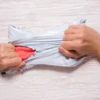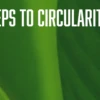Understanding the three W’s of going circular – Part 1
Hi, I’m Nicole Bassett, and I co-founded a company called The Renewal Workshop. We’ve helped brands like Carhartt, Osprey, New Balance, and The North Face restore their used and damaged goods to make their businesses more circular.
And now we’re proud to be part of Bleckmann, providing our unique renewal services to clients – and helping to make circularity a central part of the fashion industry.
What is circularity?
You’ve probably heard about circularity in recent years. It’s an important topic in different industries, but most of us just don’t have the time to dive into the detail.
So, in this series of blogs, I’m going to give you three simple answers to three questions that brands always ask me when they’re starting on their circularity journey: “What is circularity?”, “What’s the value of circularity?”, and “Where do I start?”
An ecosystem approach to business.
As a business leader, I know you’ve got to make tough decisions every day. And circularity may seem like yet another box to tick. But actually, it’s much less of a leap than most people realise.
Circularity isn’t the polar opposite of your current business model. All it means is improving our current systems of production so they can last.
The best definition of the circular economy I’ve come across is from the Ellen MacArthur Foundation: “Design out waste, keep products and materials in circulation for longer, and regenerate natural systems”1.
Sound familiar?
That’s because it’s exactly what nature’s been doing for billions of years.
Nature works in ecosystems, and every part of an ecosystem is valuable. That means there’s no time for value judgments like “old”, “used” and “new”. Nature simply uses the value in whatever’s there – whether it’s a rotting leaf or a raging waterfall. Nature thinks circular.
Human beings, on the other hand, don’t always take this approach. We chuck away clothes we consider too “old” to be useful. Even if they’ve only been worn a few times. We think linear. And look where it’s got us …
Survival of the fittest
Nature doesn’t let any value slip through the net. And neither should you. Because guess what? Smart young disruptors are already taking the lead from nature. Turning “old clothes” into new value. And turning a profit from goods they didn’t even make.
In fact, the US second-hand apparel market is expected to more than double by 2026, reaching USD 82 billion. That’s 8x faster growth2 than the overall market. And it’s a similar story in the EU3.
By thinking circular and turning used clothes into a new “raw material”, it’s possible to uncover a whole new revenue stream. One that was sitting under your nose the whole time. Want to learn how else you might lose out by not thinking circular? Read on…
What’s the value of circularity?
I’m about to tell you why going circular might just be the best investment you ever make.
But first, let’s talk about calories.
When it comes to understanding the environmental costs of manufactured goods, there’s one concept I find helpful: “Think of carbon as the new calorie”.
It’s a simple proposition. For each product that you manufacture, there’s an associated “carbon calorie count” – which helps consumers decide on the right product for them.
And this concept helps shine a light on the benefits of circularity. Because by investing in going circular, you’re not just investing in a desirable, new revenue stream …
You’re reducing the overall “carbon calorie count” of each garment you sell.
Now, let’s find out why that’s going to be so important in the years to come…
Leading on compliance
Soon, the question on apparel brands’ lips won’t be “What will it cost to go circular?” but “Why is it costing so much to stay linear?”
Well, the first reason is regulation. The EU is set to introduce a broad range of measures to target take-make-dispose behaviour in the apparel industry. This includes the European Commission (EC)’s Strategy for sustainable and circular textiles4 and Extended producer responsibility (EPR) for textiles5.
In short, these legal measures mean applying circular economy principles to all aspects of textile production, consumption, and waste management.
The headline? Polluters pay.
Textile producers will be forced to foot the bill for dealing with every single piece of clothing, shoe, or other textile product that consumers throw away – so, it’s in your best interest to make sure your products stay out of landfill!
The coming wave of legislation also includes a ban on the destruction of unsold products, and a transparency obligation requiring large companies to publicly disclose how many products they discard and destroy6. Don’t forget, your customers will be seeing these numbers, too.
Unsurprisingly, one of the best ways to reduce your textile waste and avoid the negative consequences of these policies is by adopting circularity as a key part of your business model.
And with elements of this circularity legislation already in force in some European markets, the time to act is now.
But it’s not just governments that are putting pressure on the apparel industry to go circular…
Meeting growing consumer demands
It’s not just governments who are demanding higher standards in the apparel industry.
Recent research by IBM7 shows that consumers are increasingly seeking products that are made with respect for the environment. And shoppers – particularly among the Gen-Z demographic8 – are willing to pay a premium for sustainable goods…
So not only can embracing circularity save you compliance headaches – but you’re also earning kudos from eco-savvy shoppers for being a first mover.
Your brand is your product
Incorporating circularity into your apparel business has clear benefits for your brand image.
How do I know this? Every time I’ve collaborated with top brands like Carhartt, New Balance, and The North Face, it’s been the same story…
As soon as you add that “Renewed” section to your business, your brand perception goes up. And the best part is that this pays dividends in terms of customer retention and acquisition.
Consumers are actively looking for brands that help them lead more sustainable lifestyles – so they’ll reward you with their loyalty if they see you’re consistently taking action and not just making empty promises.
On the flip side, if you don’t act, consumers will be quick to punish you. Shoppers have never been more ready to jump ship9 if a brand has a poor environmental track record.
And with fashion greenwashing crackdowns taking place in the EU10, the UK11, and the US12, there will soon be nowhere for slow movers to hide unsustainable practices.
Like the mountains of discarded clothing currently in landfill, a bad reputation sticks around…
Investing in the future of your business
Here at The Renewal Workshop, we think of going circular as a down payment on your brand’s future in the apparel industry. It’s a three-pronged strategy for cementing your company’s position as a sustainability leader:
- It’s a way to show eco-conscious consumers that you’re taking action on the most pressing problems facing our planet today – helping to ensure that the industry will still be there for generations to come.
- It creates an additional revenue stream, without the need to create new products – helping you to recoup the money you’re currently losing to digital-first resellers like Vinted and Depop.
- It’s an insurance policy against the coming wave of circularity legislation that’s about to hit the European textile industry.
Investing in the future of the planet
As a business leader, you’ve got to know exactly how the investments you make now are going to save or make you money in the medium to long term. That’s why, at The Renewal Workshop, we’ve developed a unique process to find the circularity approach that’s right for you – providing a tailored pathway for long-term circular growth.
Come back next time to find out how to get started on your circularity journey…
Best,
Nicole
1 https://archive.ellenmacarthurfoundation.org/explore/the-circular-economy-in-detail
2 https://www.thredup.com/resale/#size-and-impact
3 https://www.cbcommerce.eu/press-releases/the-rise-of-the-resale-second-hand-market/
6 https://www.theguardian.com/en...
7 https://www.ibm.com/thought-le...
8 https://www.forbes.com/sites/g...
9 https://www.warc.com/newsandop...
10 https://ec.europa.eu/commissio...














